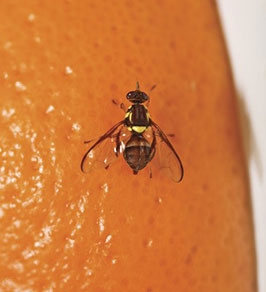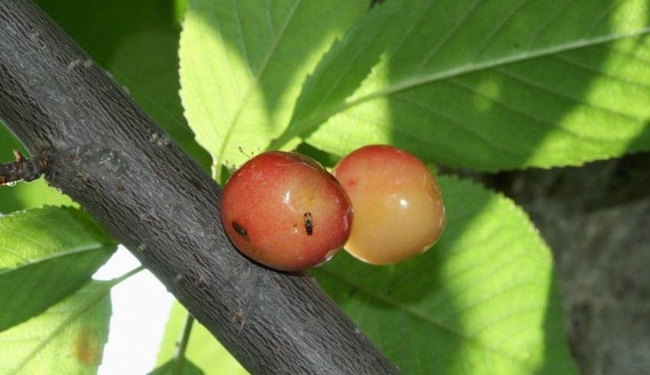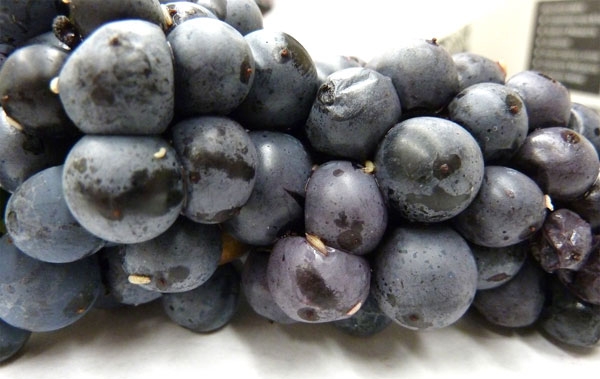
Posts Tagged: fruit fly
Notes from a Neighbor - Grower
This is a recent opinion piece in the Ventura Star, Santa Paula Times and Thousand Oaks Acorn by grower Lisa Tate:
OPINION (https://www.vcstar.com/opinion/)
Letters to the editor: Be an Ag hero with fruit flies
Ventura County Star
Keep your fruit in your backyard
Re: your Oct. 27 story, “Fruit fly in T.O. prompts county's second quarantine”: (https://www.vcstar.com/story/news/2023/10/26/ventura-county-quarantine-invasive-queensland-fruit-flies-thousand-oaks-california/71176056007/)
Ventura County residents have always shown their dedication to preserving local agriculture. Today, our farmers urgently need your help.
Recently, the Queensland fruit fly was discovered in backyard fruit trees in the Thousand Oaks area. As a result, agricultural zones in T.O. and Moorpark are now under quarantine. The CDFA, USDA, and our County Agricultural Commissioner's Office are working tirelessly to shield our local farms from this destructive pest.
The repercussions of losing this battle could be catastrophic for our county and our SOAR-protected agricultural lands. Fruit fly infestations can wipe out entire crops and impede our farmers from selling their produce locally and globally — and the exorbitant costs of treating crops to prevent infestations could force some cherished family farms out of business.
What can you do to help save Ventura County agriculture? Don't move your fruit. Be an Ag hero and keep your fruit in your backyard. Prevent the spread of fruit flies and protect our local farms by not moving your backyard fruit. Dispose of excess backyard fruit by double bagging it and placing it in the trash, not the yard waste bin for composting. If you're visiting friends or family this holiday season, resist the urge to bring home backyard fruit from other areas — don't pack a pest back to Ventura.
You can be an Ag hero. Spread awareness about the risks of moving backyard fruit, and kindly refrain from sharing your bounty with friends and family this holiday season. Let's unite as a community of Ag heroes and help protect our local farms. Taking these small steps can make a significant impact and safeguard the future of our SOAR Ag lands.
Lisa Tate
Queensland Fruit Fly - Bactrocera tryoni
90 Square Miles Quarantined
An agricultural quarantine in Ventura County, due to the discovery of a potentially destructive insect pests, has been expanded. The quarantine was declared in parts of Ventura County in October following the discovery of two Queensland Fruit Flies (QFF). The flies are native to Australia.
The Ventura County quarantine is the first one ever in the United States. They are extremely destructive, laying eggs in a variety of fruits and vegetables, and destroying the produce in the process.
Because of the mild climate, Californias are able to grow and enjoy some of the best produce I the world. Actually, many countries depend on Calfirnia-grown products. Is through the surveillance and vigialance effort of the Calfornia Department of Food and AGriducltture that thise abundant food supply is protected. One fo the biggest threst to CAlfiornia agrulgulture is th exotic fruit fly. They cn enter the country by land, sea or air. These invasive pest can werak havoc on farms, orchards and backyard produce. Over 270 crops area at risk of being infected by various species of fruit flies.
The quarantine was expanded from 76 to 90 square miles after the recent discovery of a third fly. The finds have been in the Conejo Valley. The flies were found in residential trees, but there are about 3400 acres of commercial farmland in the quarantine area. A major trapping program is underway to limit the spread of the flies, with some limited pesticide spraying occurring. The adult fly is moved by humans and the wind. The larvae (the "worm" stage) is mainly moved by moving the fruit - by humans, that is.
On the map, the original limit of the quarantine was the red line, but as now been expanded to the whole blue line area.
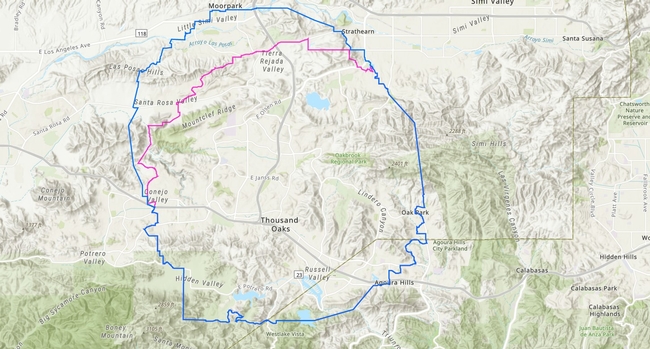
-
Mediterranean fruit fly: Los Angeles County, Leimert Park Area
-
Oriental fruit fly: San Bernardino and Riverside Counties, Redlands and Yucaipa Areas
-
Oriental fruit fly: Sacramento County, Rancho Cordova Area
-
Oriental fruit fly: Contra Costa County, Brentwood Area
-
Oriental fruit fly: Santa Clara County, Santa Clara Area
-
Queensland fruit fly: Ventura and Los Angeles Counties, Thousand Oaks Area
Options for Host Fruit and Vegetables-Processing
To prevent the spread of fruit flies via infested homegrown fruits and vegetables, residents and people moving through the fruit fly eradication area are urged not to move any fruits or vegetables from their property. Fruits and vegetables may be consumed or processed (i.e. juiced, frozen, cooked, or ground in the garbage disposal) at the property of origin. If they are not consumed or processed, dispose of them by double-bagging them in plastic bags and putting the bags in the garbage bin for collection.
Eradication Procedure
To eradicate exotic fruit fly infestations, CDFA uses an organically-formulated version of the pesticide called spinosad. Spinosad is used for organic crop production in California to control a variety of pests. It is mixed with a bait that is selectively attractive to fruit flies. The bait is applied as a paste that the fly eats, resulting in death. Before CDFA applies the material in the quarantine area, the homeowner will be contacted. The official registration label is available for viewing here:
https://ucanr.edu/sites/fruitandnut/files/74136.pdf
To report a suspected infestation of fruit fly larvae in homegrown produce, call the CDFA pest hotline at 1-800-491-1899. Growers with questions and concerns are urged to contact their local agricultural commissioner's office. More information about the flies and their treatment can be found at the CDFA website - www.cdfa.ca.gov/plant.
Fruit Fly from Down Under
|
CDFA has recorded a second detection of Bactrocera tryoni Queensland Fruit Fly (QFF) in Ventura County. This tiny but troublesome pest was found in a residential neighborhood of Thousand Oaks. CDFA considers this a major threat as it is a pest to numerous crops grown in Ventura, including citrus, avocado, peppers, tomatoes, and strawberries. |
|
To address this issue, a quarantine has been placed within a 4.5 mile radius around the detection site and will restrict the movement of all host crops out of the designated boundary until no flies are found within 3 full life cycles. Producers of crops are allowed to move their crops outside of the quarantine area but must apply multiple treatments to their crop prior to harvest. For growers with questions, contact admin@farmbureauvc.com. If you are a resident living within the quarantine zone, it's advisable not to share any homegrown fruit from your yard with friends and neighbors outside of your residence. |
|
The first sighting of the Queensland Fruit Fly in California dates back to 1985 when it was first identified in San Diego. This pest has earned a notorious reputation for wreaking havoc on fruit production in its native Australian habitat, causing an estimated annual damage cost of $28.5 million to crops. While we can't be certain that this fly will establish itself as a major nuisance in our region, the importance of preventing its spread cannot be understated. |
|
QFF has shown an ability to adapt to various environmental conditions and temperatures, making it a potential menace to our citrus crops. Once fruit fly populations take root, they become notoriously challenging to manage. |
|
The Queensland Fruit Fly has an interesting life cycle. It's active during the day but has a peculiar preference for nighttime rendezvous when it comes to mating. Adult female flies lay multiple eggs inside a punctured fruit, which then hatch into larvae after a 2-4 day incubation period. These hungry larvae devour the fruit's flesh with sharp jaws, leading to premature decay and fruit drop. The larvae then enter the soil, pupate, and emerge from the soil as adults. Astonishingly, adult female Queensland Fruit Flies can live for many months, and in some cases, even surpass a year! While the larvae have a taste for fruit, the adult flies have an unconventional preference for leaf surface bacteria, using them as their primary source of protein. |
|
The arrival of the Queensland Fruit Fly in Ventura County may seem like a tiny issue, but its potential impact on our local crops is quite significant. |
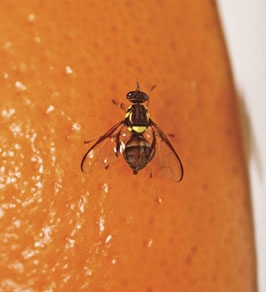
QFF
Samba and the Fruit Fly
Scientists use samba wasps to manage the invasive spotted-wing drosophila, a key pest of small andstone fruit worldwide
By Vaughn Walton
https://www.ishs.org/system/files/chronica-documents/ch6203.pdf
Recently, spotted-wing drosophila (Drosophila suzukii, SWD) has appeared in fruit production areas worldwide. This invasive pest that resembles a vinegar fly, is highly damaging to berries and stone fruits. This fly infests these fruits as they ripen, costing half a billion dollars of crop damage annually in the USA. Affected crops include strawberry, raspberry, blackberry, blueberry, cherry, and wine grape.
Most vinegar flies attack overripe fruit laying eggs in the soft fruit. Spotted-wing drosophilhas a saw-like ovipositor, and can lay its eggs into ripening, susceptible fruit. The saw-like ovipositor allows SWD to cut into the firm outside of fruit and push its eggs in. These eggs are laid directly under the fruit surface area and immediately, sometimes even within hours, start to hatch. Hatching larvae will start feeding on the pulp of the affected fruit. Within two or three days, feeding larvae soft-en the pulp and provide entry to microorganisms, resulting in unacceptably soft and spoiled fruit. Within a one-week period, under ideal conditions, larvae will emerge from fruit. Emerging SWD larvae can pupate either in fruit or outside, after which adults emerge to repeat the life cycle. The life cycle can be completed within as little as ten days, with up to ten generations per season, resulting in explosive pest populations.
Scientists are researching control measures for SWD. One possibility for control includes the release of insect predators. In Oregon, USA, during summer of 2022, scientists are releasing a parasitoid wasp, also called the samba wasp (Ganaspis brasiliensis) as a predator, to combat the highly damaging and invasiveness, spotted-wing drosophila (Drosophila suzukii, SWD). Samba wasp releases in the Willamette Valley are part of a worldwide bid to help manage SWD. Samba wasp is also being evaluated by Kent Daane at UC Berkeley, so keep your eye on what's going on in California, as well.
Read the Samba Story. Images supplied by Vaughn Walton

SWP blueberry infested

SWP Daane

SWP samba wasp
Organic Solution for Fruit Flies
A recent paper shows that a food-grade coating can successfully reduce the damage of cherry fruit fly on cherries. This has implications for control of olive fruit fly, spotted-wing drosophila (on blueberry and other bush berries), Mediterranean fruit fly and other tephritid flies. Read on:
Evaluation of Organic, Food-Grade Hydrophobic Coatings for Suppressing Oviposition and Increasing Mortality of Western Cherry Fruit Fly (Diptera: Tephritidae)
Abstract
To reduce risks and concerns of extensive insecticide use for controlling tephritid fruit flies, non or less toxic organic management options to the use of insecticides alone for fly control are needed . One such option is the use of physical or chemical barriers sprayed on fruit to protect fruit from fly attack. Surround wettable powder (kaolin) is the major organic barrier that has been developed that protects fruit (against sunburn) and deters insects. However, Surround has not been adopted to any large extent by growers for use against fruit flies due in part to the white residue it forms on fruit. A product that protects fruit while leaving no visible residue on fruit surfaces might be more acceptable for use.
Recently, the product HydroShield (original formulation; Cuticle Supplement), a nonwax organic food-grade hydrophobic coating that simulates plant cuticles, was developed that protects cherries from water-induced cracking . Unlike Surround, HydroShield forms an invisible (to human eyes) coating on cherries. HydroShield incidentally also helps protect fruit against attack by insects, specifically Drosophila suzukii (Matsumura) (Diptera: Drosophilidae), reducing oviposition by this fly in Sweetheart cherries.
Newer organic options for protecting fruit from tephritid fruit fly attack are needed to reduce extensive insecticide use. Here, we evaluated organic, food-grade hydrophobic coatings that help protect sweet cherries (Prunus avium L.) from water-induced cracking for suppressing attack on cherries by western cherry fruit fly, Rhagoletis indifferens Curran (Diptera: Tephtitidae), as well as for their effects on fly mortality. Three formulations of coatings called HydroShield 13.20, 13.22, and 13.28 that form invisible elastic barriers on cherries and that consist of complex carbohydrates, fatty acids and occlusive agents, solvents, emulsifiers, emollients, surfactants, and other ingredients were tested. In the laboratory, fly visits on and oviposition in HydroShield-coated cherries were 66.1–92.8% and 59.1–99.5% lower, respectively, than in controls. The mean number of dead female flies exposed to HydroShield-coated cherries was 69.4–94.6% greater than of females exposed to control cherries. In the field, three sprays of HydroShield 13.22 and 13.20 on sweet cherry trees in 2020, when fly densities were high, reduced larval infestations in cherries by 32.1% and 31.8%, respectively. In the field in 2021, when fly densities were lower, three sprays of HydroShield 13.22 and 13.28 reduced infestations in cherries by 90.5% and 86.8%, respectively, but sprays also reduced cherry size and toughened cherries. HydroShield formulations show promise in protecting sweet cherry from attack by R. indifferens, but further testing is needed to improve formulations so that they suppress fly oviposition without affecting cherry quality.
https://academic.oup.com/ee/advance-article/doi/10.1093/ee/nvac033/6590995?login=false
Adult drosophila laying eggs
Maggots doing their thing on blueberry

